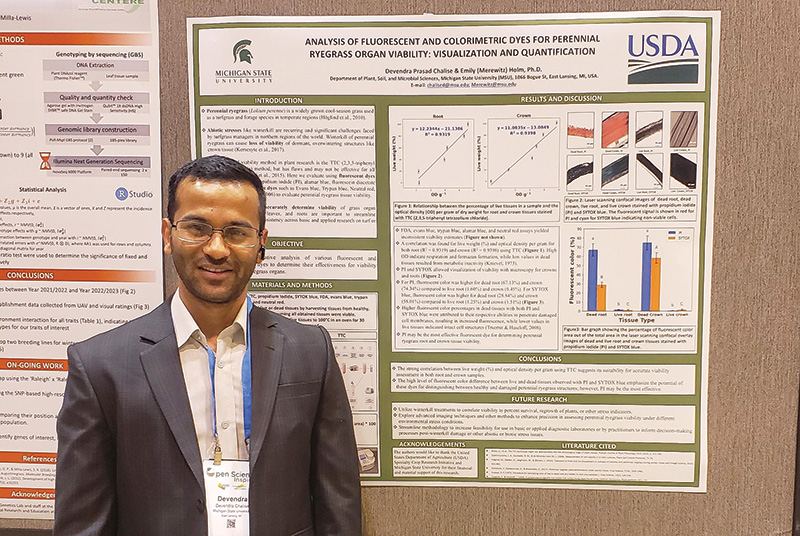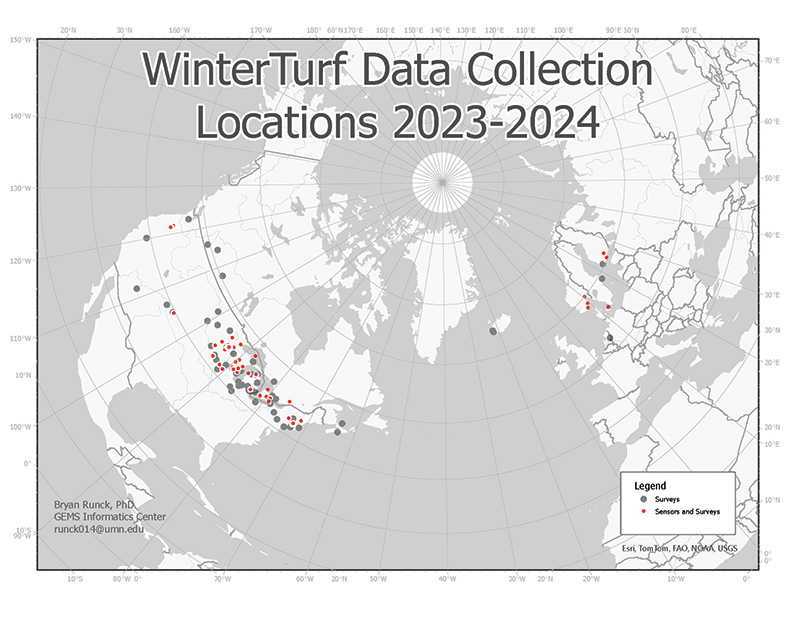
Analysis of fluorescent, colorimetric dyes for perennial ryegrass organ viability: Visualization and quantification
Perennial ryegrass (Lolium perenne) is a vital turf and forage grass species in temperate regions, but its growing area is restricted by susceptibility to winterkill. After experiencing winter stress, turfgrass can suffer complete loss, apparent death followed by regrowth, or no visible damage. As a result, golf course and turf managers face the challenge of determining whether to replant. Relying on regrowth to make this decision can delay the golf course opening by approximately two to three weeks, leading to significant revenue loss. Replanting also demands substantial investment. Crown tissues are the primary overwintering structures in many perennial grass species; therefore, research specifically evaluating crown viability methodologies is necessary.
The triphenyl tetrazolium chloride (TTC) method, commonly used for roots and seeds, has been rarely applied to assess grass crown viability. This study aimed to assess the viability of perennial ryegrass roots and crowns using fluorescent dyes (SYTOX blue, propidium iodide (PI) and fluorescein diacetate (FDA)) and spectrophotometric dyes (TTC, Evans blue, trypan blue, alamar blue and neutral red). Live and dead root and crown tissues were used, with dead tissues obtained by heating at 212 F (100 C) for 30 minutes.
PI and SYTOX blue revealed distinct fluorescent color disparities between live and dead tissues, with dead tissues exhibiting higher fluorescence (67.13% and 74.34% for PI, 28.84% and 58.01% for SYTOX blue in root and crown, respectively). TTC showed a strong correlation between live weight percentage and optical density per gram (R² = 0.9319 for roots and R² = 0.9398 for crowns). These findings highlight the potential of PI and SYTOX blue for distinguishing between healthy and damaged perennial ryegrass at the microscopic level, aiding in mechanistic research.
The strong correlation of TTC with viability indicates its utility for crown tissues using spectrophotometric methods. Therefore, this research is valuable for determining whether to replant turf on golf courses after snowmelt, contributing to more informed and effective turfgrass management strategies and ultimately reducing the impact of winterkill damage. However, future research should explore these techniques to enhance viability assessment precision, particularly under diverse environmental stress conditions.
— Devendra Prasad Chalise (chalised@msu.edu) and Emily Merewitz Holm, Ph.D., (merewitz@msu.edu) Michigan State University, East Lansing

Superintendents’ help sought for winterkill research project
While turfgrass researchers have been effective at delivering solutions for many agronomic challenges, answers to the problem of winter damage have been elusive. One of the primary reasons for this is that every winter is different — if we want to study winterkill of annual bluegrass on a research golf green in Minnesota, we might get the right combination of winter conditions to kill annual bluegrass every four to five years.
For the last three years, a team of researchers from across the U.S. and northern Europe has been working collaboratively to identify solutions to winter stress damage. Instead of relying on conditions at a single site, we are enlisting the help of golf course superintendents across the globe to take data on their courses every winter, in the expectation that each winter, someone, somewhere will have winter damage. Collecting data at each of these courses will allow us to discover the combinations of conditions that are responsible for damage and even predict when damage might occur.
For this data collection to be effective, we need your help. If you are a golf course superintendent where winterkill of cool-season grasses could occur, please consider helping our team out by signing up at z.umn.edu/interest-survey. We’ll ask you to monitor at least one green throughout the winter — measure snow, take pictures and record any other interesting observations on a regular basis. Early data modeling results are promising, and with your help, we can make even more progress toward our goal of reducing the harmful effects of winter stresses on golf courses.
— Eric Watkins, Ph.D., (ewatkins@umn.edu) University of Minnesota, St. Paul
Note: The WinterTurf project is funded by the United States Department of Agriculture Specialty Crop Research Initiative and is a collaboration between several institutions: University of Minnesota, University of Wisconsin, University of Massachusetts, Michigan State University, Oregon State University, Iowa State University, Rutgers University and the Norwegian Institute of Bioeconomy Research.
Darrell J. Pehr (dpehr@gcsaa.org) is GCM’s science editor.